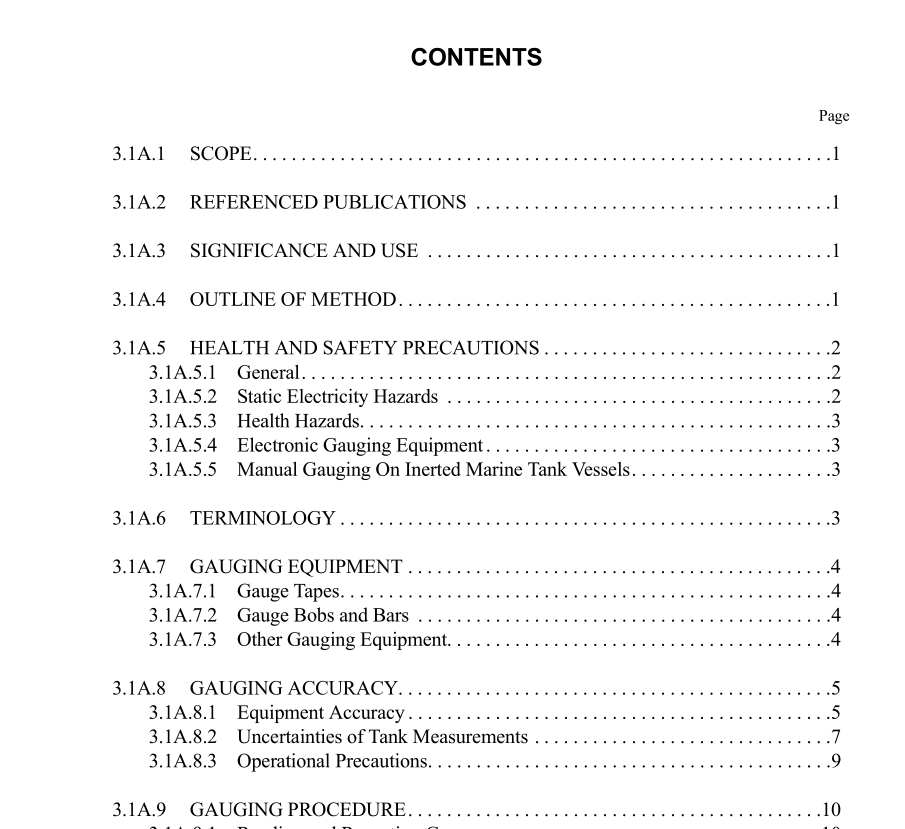API MPMS 3.1A pdf download

API MPMS 3.1A pdf download.Manual of Petroleum Measurement Standards Chapter 3—Tank Gauging
3.1A.1 Scope
This standard describes the following: (a) the procedures for manually gauging the liquid level of petroleum and petro- leum products in non-pressure fixed-roof, floating-roof tanks and marine tank vessels, (b) procedures for manually gauging the level of free water which may be found with the petro- leum or petroleum products, (c) methods used to verify the length of gauge tapes under field conditions and the influence of bob weights and temperature on the gauge tape length, and (d) the influences that may affect the position of gauging ref- erence point (either the datum plate or the reference gauge point). Throughout this standard the term petroleum will be used to denote petroleum, petroleum products, or the liquids normally associated with the petroleum industry. The method used to determine the volume of tank contents determined from gauge readings is not covered in this stan- dard. The determination of temperature, API gravity, and sus- pended sediment and water of the tank contents are not within the scope of this standard; however, methods used for these determinations may be found in the API Manual of Petro- leum Measurement Standards (MPMS).
3.1A.3 Significance and Use
Gauge readings of petroleum and free water are used with tank capacity tables to determine the total observed volume (TOV) of the petroleum contained in the tank. The total observed volume is used with various correction factors to calculate the gross standard volume (GSV), the net standard volume (NSV), and other volumes of interest. See “Calcula- tion of Petroleum Quantities” in MPMS Chapter 12. This standard is applicable for gauging quantities of liquids having Reid Vapor Pressures less than 103 kPa [15 pounds per square inch atmospheric (PSIA)].
3.1A.4 Outline of Method
There are two basic types of procedures used for obtaining a gauge reading—innage and outage (dip and ullage). For the innage method, the gauge reading shall be defined as the measure of the linear distance along a vertical path from the datum plate or tank bottom to the surface of the liquid being gauged. An innage gauge is a direct measurement of liquid level. For the outage method, the gauge reading shall be defined as the measure of the linear distance along a vertical path from the surface of the liquid being gauged to the tank reference gauge point. An outage gauge is an indirect mea-surement of liquid level. Figure 1 illustrates the innage and the outage methods for obtaining a gauge reading. Innage gauges are generally preferred, as these may reduce the effect of tank reference point movements. However, there are circumstances where outages will be more applicable. When the outage method is used, every effort should be made to periodically verify the tank’s refer- ence gauge height for both opening and closing conditions to ensure it has not changed. If the reference gauge height has changed, use of innage gauges is recommended.
3.1A.5.1 GENERAL
These health and safety precautions represent good prac- tice. This list is not necessarily complete or comprehensive. Refer also to the health and safety precautions described in API RP 2003, API RP 49, API RP 55, 29 CFR 1910.134 (Respirator Standard), or other applicable state/federal regu- lations, and described in Appendix B of this standard. Personnel involved with the gauging of petroleum and petroleum-related substances should be familiar with their physical and chemical characteristics, including potential for fire, explosion, and reactivity, and with the appropriate emer- gency procedures as well as potential toxicity and health haz- ards. Personnel should comply with the individual company safe operating practices and with local, state and federal regu- lations, including the use of proper protective clothing and equipment.









